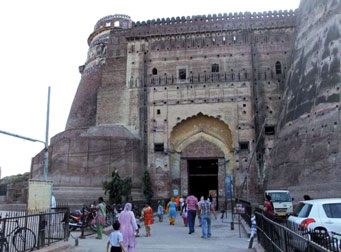Legacy in ruins
The site of Razia Sultan's incarceration, the Bathinda Fort
languishes in neglect
The 2000-year-old Qila Mubarak in Bathinda is considered to have a
shared legacy. Built by Raja Dab during 90-110 AD, the fort was
'visited' by Guru Gobind Singh in 1705. To mark this event, a small
shrine was built inside the fort by the Maharaja of Patiala in 1835.
 |
|
Qila Mubarak: Deserves
a better deal |
Built originally of mud bricks, the fort has a square plan with 32
small and four large bastions placed at the corners that stand witness
to the history of its capture by warring luminaries like Mahmud Ghazni,
Mohammed Ghouri and Prithvi Raj Chauhan. Being located enroute from the
northwest, it was once called *Tabar-e-Hind* (gateway to India). It was
here that Razia Sultan, the first and only woman emperor who ruled from
Delhi, was incarcerated on her defeat at the hands of Malik Altunia, the
then governor of Bathinda.
Immortalised on-screen by Bollywood director Kamal Amrohi, Razia
Sultan has remained a subject of many legends.
Not only does she feature in an online comic strip, a piece of
historical fiction entitled Razia: Queen of India has been in
circulation, too. Since the location of her grave has remained a
contested subject amongst historians and archaeologists, Qila Mubarak
remains the only historical landmark reminding future generations of the
heroics of this legendary emperor.
Subsequent to the collapse of one of the fort's bastions, atop which
the gurudwara built in 1835 was located, permission for temporarily
shifting the shrine to a sprawling open space inside the fort was
granted in the early 1990s. Though the bastion has since then been
restored, the temporary structures have continued to persist in the
inner precinct of the fort.
The fort's boundary wall has collapsed at several places exposing the
neglect it has been subjected to; there were even attempts of
encroachment close to the fort's peripheral wall in the recent past.
Though restoration is currently under way, its pace is rather slow
considering the extent of damage left by the passage of time and
neglect.
For India's only woman emperor, who ruled between 1236 and 1240 AD,
the spirit of religion was more important than its parts. For being
tolerant of other religions, Razia Sultan had run into opposition from
the nobles.
Should her legacy be made to face the same fate? Qila Mubarak surely
deserves a better deal.
-The Hindu
|


